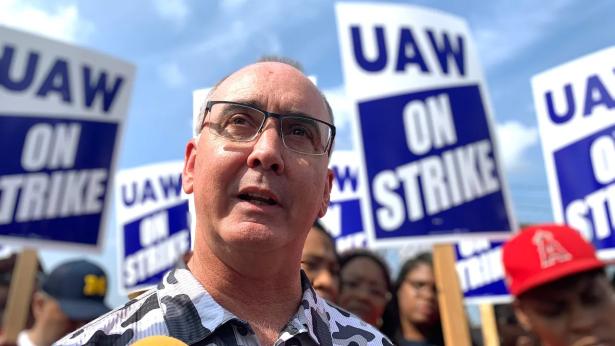With three historic tentative agreements in hand after six weeks on strike, the United Auto Workers is looking to galvanize the rest of the U.S. labor movement by calling on other unions to align their contract expiration dates with the UAW's—a move that would give workers maximal leverage at the bargaining table and the ability to strike together, if necessary.
If ratified by UAW members, the union's four-and-a-half-year contracts with General Motors, Ford, and Stellantis would expire on April 30, 2028. Should the contracts lapse without an agreement before that deadline, the UAW would be positioned to strike on International Workers' Day, commonly known as May Day.
In a speech on Sunday night in Detroit, UAW president Shawn Fain made clear that the April 2028 expiration date was chosen strategically, with an eye toward invigorating a labor movement that has been under coordinated assault by corporations and their political allies for decades.
"May Day was born out of the intense struggle by workers in the United States to win an eight-hour day. That's a struggle that is just as relevant today as it was in 1889," Fain said. "Even though May Day has its roots here in the United States, it is widely celebrated by workers all over the world. It's more than just a day of commemoration, it's a call to action."
Aligning contract expiration dates, Fain argued, would allow unions to "begin to flex our collective muscles."
"If we are going to truly take on the billionaire class and rebuild the economy so that it starts to work for the benefit of the many and not the few, then it's important that we not only strike, but that we strike together," said Fain, the first UAW president to be directly elected by rank-and-file members.
After months of contract negotiations and six weeks of picketing, the UAW secured tentative deals with General Motors, Ford, and Stellantis that surpass the gains of any Big Three contract in decades after years of declining real wages and surging corporate profits.
Under the tentative Ford agreement—which is similar to the deals with the other two automakers—the top wage for UAW members would jump by over 30% to more than $40 an hour and the starting wage would rise to roughly $28 an hour, a 68% increase, over the life of the contract. The UAW valued the gains in the deal at more than four times those of the 2019 contract with Ford that recently expired.
The UAW also tentatively won the right to strike over plant closures at Ford and Stellantis and union protections for electric battery plant workers at General Motors.
The victories came at the tail end of a major year for organized labor. Across the U.S., more than 450,000 workers—from nurses to hotel employees to actors—have walked off the job this year in pursuit of better wages, benefits, and working conditions. Other workers in critical sectors, including airline pilots, appear poised to strike in the near future.
Though 2023 was one of the biggest years for strikes in recent history, it still pales in comparison to the 1970s, when more than a million workers went on strike each year. Today, union membership is at an all-time low of 10.1% even as public support for unions sits at its highest point since 1965.
Fain said he hopes the UAW's victories in contract talks with the powerful Big Three will mark "a turning point in the class war that's been raging in this country for the past 40 years," adding that the union is setting its sights on non-organized car companies such as Tesla, Toyota, and Honda.
"One of our biggest goals coming out of this historic contract victory is to organize like we've never organized before," Fain said. "When we return to the bargaining table in 2028, it won't just be with the Big Three. It will be the Big Five or Big Six."
Jake Johnson is a senior editor and staff writer for Common Dreams.


Spread the word